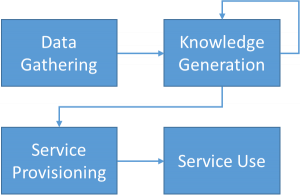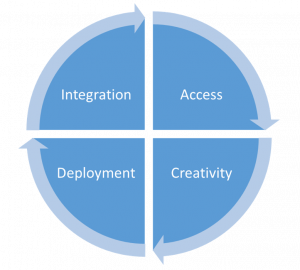Summary Grassroot Smart Cities
Introduction
Cities are complex systems, characterized by massive numbers of interconnected citizens. In the advent of new technologies, such as IoT or mobile applications, various domains within these systems can be enhanced to support the decisions of its citizens, businesses, or administration.
Ideally, a city follows a vision how to improve its smartness to generate value for its citizens. However, this top-down approach is often not applied consequently in many cities. Reasons are a reluctance to invest in new approaches due to a critical financial state or a conservative view averse to an approach that makes only sense regionally. A typical city already manages a big portfolio of IT solutions and it’s difficult to know in advance, what technologies and innovations will be used by end users.
In a bottom-up approach, citizens themselves build their sensor and actuators networks and smaller service agencies can easily generate data-driven solutions for the citizens. In such C2C (citizen-to-citizen) and C2G (citizen-to-government) scenarios data is collected in the public space by citizens themselves, guaranteeing a certain usefulness and fulfilment of actual citizen requirements.
Roles
Various roles are required in such a scenario, allowing non-technical people to add value to such a solution. Every interested person or entity can hook into the process; typically, roles such as
- Data gathering (electronics, deployment)
- Knowledge generation (heuristics, analysis)
- Service provisioning (IT, Web, Mobile)
- Service use (feedback)
are all part of a solution stack.
Data can be generated from city organizations (parking places, current position and weight of waste containers, current waiting times in one-stop-shops, sewage water quality, …). Also, businesses or urban industry can generate useful data for the public, such as power usage (smart metering) or use of workforce (optimization of public transport). Finally, each citizen can generate data by himself; todays smartphones contain a variety of sensors that, anonymized, can be used by analytical processes for a variety of solutions.
Data itself is often not meaningful enough; it’s typically very technical, must be interpreted and only makes sense in some context, such as current location, time, weather condition, etc. To leverage this data, knowledge generators enrich the raw data und generate insights. The garbage truck driving around on a weekend is probably scheduled for maintenance; after a street festival, however, it may be working. An average waiting time of 0 minutes in the tax office is irrelevant at 10PM. Generating knowledge is a recursive process: the output from one step can be useful for another layer of knowledge engineering. Each layer can be used by several service providers and is normally exposed as an API.
It makes sense to separate the knowledge generation from its actionable representation by a service provider, as different disciplines are involved (data science vs IT). Services can be provided in many forms, such as a simple My-City app consolidating knowledge from various inputs. A service provider can also use the generated knowledge to feed the ERP of the city. Every layer can act as a service provider; the city itself providing a service to its citizens, companies or also private interest groups that offer a visualization of the knowledge on their website to other citizens.
The simplest case of a service user is the citizen himself. He can view and act on the generated knowledge either on demand (API, mobile or web) or by notifications (SMS, e-mail). The greatest beneficiary is the city itself; the generated knowledge supports the decision processes and helps optimising or extending the managed infrastructure.
[ ]
]
Citizen participation
Each single individual can participate in the process; although the data gathering aspect involves a technical aspect, todays approaches in Open Source Hardware (e.g. Arduino, Raspberry Pi) have greatly reduced the threshold for inclined citizens to create new sensors. Furthermore, many cloud services (e.g. AWS IoT) already exist accepting and storing received sensor data for further processing.
Generating knowledge requires a lot of domain specific involvement. Engineering on data from a sewage water sensor is ideally done by a chemist, whereas the data from ozone sensors placed within the city is best analyzed by an environmental scientist. The actual implementation can either be done within an easy to use business rule engine or delegated to a programmer.
Providing services is typically an IT job. However, many services and frameworks exist that greatly simplify this process and reduce the time to generate a prototype.
Finally, in many scenarios it makes sense to involve a feedback loop to get information from the users back into the system. This improves the heuristics, deployment density or the use cases of the visualization.
Conclusion
Such approaches are not new: open source software is also initialized by individuals instead of organizations. Many aspects or OSS-generation, such as non-profit incubators or freemium business models, can be used in a similar manner.
[ ]
]
Enabling the creativity of citizens in various aspects of the solution generation not only increases the smartness of a city, but also improves its ICT competences and allows other entities (other cities, state, or government level) to evaluate the usefulness and acceptance of a service. Decoupling the process from a classical top-down approach speeds up the creation and increases the usefulness of new citizen services. The citizen can start the vision.